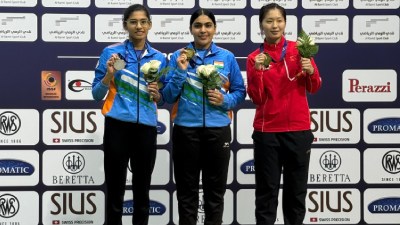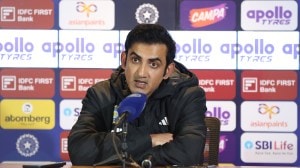On Valentine’s Day, a lesson from ‘Sankarabharanam’: Repudiate imagined binaries
A politics of cultural anxiety and revival seeks to foster a history of defeat and victimhood and inevitably produces a joyless politics underlined by violence. Hug the cow if you wish, but not to upset the Valentine's Day mood or in fear of any “invading” culture.
 Sankarabharanam was dubbed into Tamil and Malayalam and was a roaring hit across southern India, partly because of its music. (YouTube)
Sankarabharanam was dubbed into Tamil and Malayalam and was a roaring hit across southern India, partly because of its music. (YouTube) Happy Valentine’s Day! The cows have been spared this time, of course. The Animal Welfare Board of India, a body under the Union Ministry of Fisheries, Animal Husbandry and Dairying, withdrew its directive that February 14 be celebrated as “Cow Hug Day”.
Someone in the power structure realised — perhaps, because of the meme fest on social media — that the order had turned the government into an object of ridicule, within and outside the country. Agrarian cultures do care for cattle, not just the cow, as evident in festivals such as Pongal. So, the concern of the Animal Welfare Board of India was a little misplaced and was interpreted as a spoiler for Valentine’s Day, which has been targeted by the Hindu right on cultural grounds. In fact, a sentence in the “Cow Hug Day” notification was a pointer to the politics that drove some babu to come up with this bright idea. The notification said: “Vedic traditions are almost on the verge of extinction due to the progress of west culture over time. The dazzle of western civilization has made our physical culture and heritage almost forgotten.”
This fear of being overwhelmed by the “dazzle of western civilisation” and the anxiety of our culture and heritage being “forgotten” is a force that shapes conservative politics everywhere. In India, it has got enmeshed with Hindu communalism and victimhood to trigger events that range from renaming cities, streets, gardens and whatnot to policing diet, literature, cinema, and so on. It has also created false or imagined binaries — for instance, India and the West, Hindu and non-Hindu civilisations and traditions — that has led to category confusions and reduced critical debates on the colonial experience into political grandstanding and cultural vandalism.
In his study on the crisis in literary criticism in Indian languages, After Amnesia, Ganesh Devy wrote: “The term ‘India’ may be valid in the pages of an atlas, but as a cultural label it is hopelessly inadequate and simplistic. A product of colonial historiography, the term brings with it a politically coloured self-image and the suggestion of cultural amnesia. It can be said that colonialism gave rise to an equally false image of the West in India, an image that is larger than life, static and apparently invisible. Accordingly, the Indian view of the West has remained fraught with idealisation, arbitrary fragmentation and unhistorical reductions. This disfiguring colonial epistemology has created false frameworks of cultural values and has stratified knowledge into superior (Western) and inferior (Indian) categories.” The argument for inverting this hierarchy — Indian as superior and Western as inferior — also follows the same colonial epistemological logic.
There is an interesting scene in the celebrated film, Sankarabharanam (1979). The film was in the news recently because two iconic artists — director K Viswanath and singer Vani Jayaram — associated with it passed away earlier this month. An underlying theme of Sankarabharanam is the cultural anxiety that Carnatic music is being sidelined in favour of Western pop music. Sankarabharanam Sankara Shastri, a classical singer famous for his mastery over the raga, Sankarabharanam, has fallen on bad days as the audience has started to move away from Carnatic music. One night, his sleep is disturbed by a raucous group of youngsters practising what they consider to be Western popular music. When Shastri confronts them, he is insulted by the young men who tell him that his Sankarabharanam is no match for Western musical scales. Shastri challenges them and exposes their limited understanding of music. Thereafter, he chides them in English: “Hereafter don’t be silly, stupid and childish. Music is divine whether it is Indian or Western. Who are we to decide one type of music is great and the other is cheap.”
It reveals a certain maturity and also confidence in one’s own culture to compare different musical traditions with such equanimity. Sankarabharanam was dubbed into Tamil and Malayalam and was a roaring hit across southern India, partly because of its music. It is also said that the film rekindled renewed interest in Carnatic music. Ironically, the songs, set to Carnatic ragas, were sung by Viswanath’s cousin, the incomparable S P Balasubramaniam, who had no training in classical music.
The ongoing attempts to rewrite history or “fill in the gaps”, as Union Minister Dharmendra Pradhan said in Parliament, seem focussed on reviving what is imagined to be a glorious past. It, of course, ignores the process of cultural osmosis that tends to happen when traditions and cultures interact. These interactions are not necessarily restricted to “Indian” and “western” cultures and traditions; they may also involve the so-called margi and desi traditions. The outcome of these interactions is generally richer and more complex forms of cultural expressions. Simply put, the anxiety over western culture or “Mughal culture” erasing “Indic culture” is unwarranted.
Malayalam poet and critic Ayyappa Paniker would argue that only self-renewal and retrieval are desirable in the cultural space. Going back is out of question, he would say. A politics of cultural anxiety and revival constantly frames all questions in binaries, tries to manufacture an other (western civilisation, Mughal rule) and seeks to foster a history of defeat and victimhood. It inevitably produces a joyless politics underlined by violence. Hug the cow if you wish, but not to upset the Valentine’s Day mood or in fear of any “invading” culture.
amrith.lal@expressindia.com
- 01
- 02
- 03
- 04
- 05































